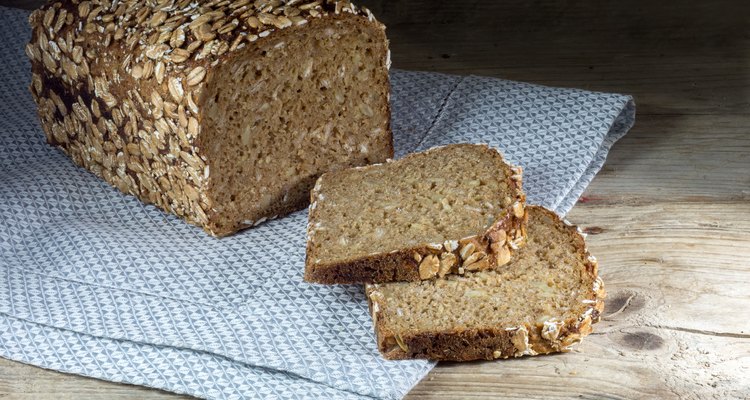
Maren Winter/iStock/Getty Images
The Essenes were a Jewish sect who flourished around the time of Christ. They lived an ascetic lifestyle and practiced vegetarianism. Their staple food was bread made from sprouted whole grains or berry roots, which were finely ground, mixed with water, and cooked at low temperatures in order to preserve the vitamins, minerals and enzymes. Essene bread has become popular in recent years and sometimes includes nuts, seeds, raisins, dates and herbs, which can make the bread more like a moist, hearty muffin. The nutritional content of Essene bread provides many benefits.
Natural Plant Enzymes
Essene bread is made from sprouting, or germinating, grains such as wheat, rye, spelt and buckwheat. Once finely ground, the grains are mixed with water and cooked at temperatures between 45 and 60 degrees C for 10 to 12 hours. Due to this process, Essene bread has been called a “living loaf” because the grains are partially raw and the enzymes are left in-tact. These plant enzymes are beneficial for properly digesting the fibrous material, seeds and nuts in the intestines, which extracts out more nutritional content. The process of sprouting also neutralizes phytic acid, a substance present in grains that inhibits absorption of nutrients, as cited in “Biochemical, Physiological and Molecular Aspects of Human Nutrition.”
Rich in Vitamins And Minerals
When grains, seeds and nuts are germinated, their nutritional content improves and becomes more available to people. Because Essene bread is not baked at high temperatures, more vitamins, minerals and amino acids are available that would otherwise be destroyed. For example, sunflower sprouts are high in vitamins A and C, while bean sprouts are high in vitamin C, iron and potassium, according to “Contemporary Nutrition.”
Commercial bread manufacturing uses only the endosperm of the wheat kernel, which contains mainly carbohydrate and very little vitamin or mineral content. The commercial milling of grain into white flour removes the bran and the germ, which results in the loss of natural fiber and numerous vitamins and minerals. To compensate, bread manufacturers often add back thiamine, riboflavin, niacin, folic acid, calcium and iron. Essene bread, on the other hand, retains all the nutrients from its grains.
High in Antioxidants
Sprouted grains, seeds and nuts are high in protective antioxidants. Antioxidants eliminate the by-products of oxidation in the body, referred to as free-radicals, which are thought to be responsible for aging, tissue damage and potentially cancer.
High in Fiber
In addition to being very digestible, sprouted grains are an excellent source of fiber and plant protein. Fiber slightly expands in the digesting tract, which can produce a feeling of fullness, clean the colon and promote regular bowel movements. High-fiber diets have also been shown to decrease blood cholesterol levels and reduce the risk of cardiovascular disease, according to MedlinePlus.
Reduced Allergic Reactions
In highly cooked form, wheat can cause mucus congestion, allergic reactions and constipation in some people. However, within sprouted wheat, the starch is mainly converted to simple sugars, which often allow wheat intolerant people to eat Essene bread with far fewer problems. According to “Nutritional Sciences,” sprouted grains also break down the lectins that some people are sensitive or allergic to.
Related Articles

Bulgar Wheat Vs. Couscous

What Is Artisan Bread?

How to Freeze Brioche
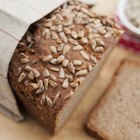
Russian Rye Bread vs. Pumpernickel

What Additives Are in Flour?

Does Yeast Cause Holes in Bread?

Can You Make Dumplings With Corn Starch?

Is Wheat Grass an Alkalizing Food?

What Is Unleavened Bread?
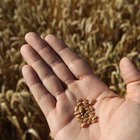
How Is Wheat Processed?
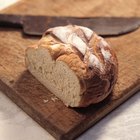
Does Heat Kill Lactobacillus Bacteria ...

How Many Calories in Gluten-Free Bread?

What Is Arnel Vintage Material Fabric?
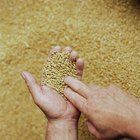
How to Ferment Grains

Different Types of Flannel Fabrics

Chemicals in Enriched Flour

What Is a Synthetic Polyester Fabric?

Alternative Flours to Make Pizza

How to Keep Sandwich Bread Fresh All ...

How to Soften Overly Hard Bread
References
- “Biochemical, Physiological and Molecular Aspects of Human Nutrition”; Martha Stipanuk; 2006
- “Contemporary Nutrition”; Gordon M. Wardlaw; 2010
- MedlinePlus: Fiber
- “Nutritional Sciences”; Michelle McGuire; 2007
Writer Bio
Owen Bond began writing professionally in 1997. Bond wrote and published a monthly nutritional newsletter for six years while working in Brisbane, Australia as an accredited nutritionalist. Some of his articles were published in the "Brisbane Courier-Mail" newspaper. He received a Master of Science in nutrition from the University of Saskatchewan.
Photo Credits
Maren Winter/iStock/Getty Images